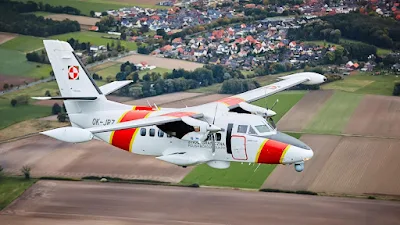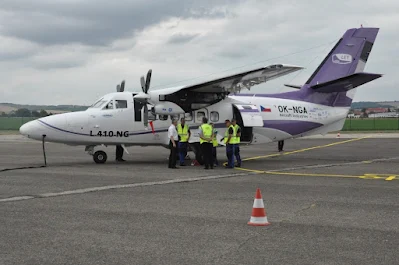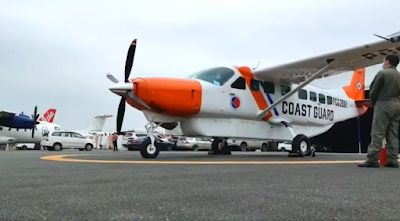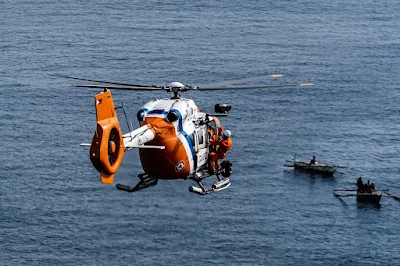The Philippine Coast Guard currently plays an integral role in enforcing its core mandates, especially in highly heated areas of concern, such as the West Philippine Sea as its patrol vessels does its job in deterring intruding vessels in the area like the Chinese Coast Guard vessels entering the country's Exclusive Economic Zone or the Chinese maritime militia that played a role in this shady scheme called 'gray-zone tactics'.
As the maritime law enforcement agency under the Department of Transportation pursues its own form of modernizing its array of ships and equipment that comes separate to the ones provided to the Armed Forces of the Philippines, the Philippine Coast Guard's tender for an aircraft comes with a closer ties with a Central European country that has the know-how in aviations-related production that can provide support to the agency's ongoing improvement of its capabilities.
INTRODUCTION
 |
| This is a LET L-410NG aircraft of the Polish Border Guard. Image Source. |
Czech Prime Minister Petr Fiala recently visited the Philippines as part of his state visit from April 16 to 18, 2023, as the first leg of his 10-day tour across Asia that involves other countries like Vietnam, Indonesia, and Uzbekistan, as part of his efforts of bolstering ties with the said countries as the Czechs are creating a counterbalance on China's dominance in terms of trade that it has a huge market share, attempting to reduce reliance to this Asian regional giant.
In the Philippines, the Czech Prime Minister said that his country considers delivering air assets for the Philippine Coast Guard to use, which can consider as an interesting development within the agency, coming alongside other updates related to the maritime law enforcement agency, such as their proposals of adding more Teresa Magbanua-class Multirole Response Vessels on top of the two vessels of that type already active in Philippine Coast Guard service.
It comes as personalities belong to either of both chambers of the Philippine legislative branch - the House of Representatives and the Senate, are pushing for a legislation that will provide a framework as a way for the Philippine Coast Guard modernizes itself for the better, in a way that it resembles the Revised AFP Modernization Program although this emphasizes more on providing the agency the tools it needs to enforce its mandate in the West Philippine Sea.
This is on top of already-acquired Philippine Coast Guard vessels such as the Gabriela Silang-class Offshore Patrol Vessels made by France's OCEA and multirole response vessels such as the ones coming from Japan. These in which will help the Philippine Coast Guard increase their patrolling times in this highly contested area, showing that the country have its presence and a way of signaling that areas in the West Philippine Sea, such as the Kalayaan Island Group, are part of the Philippine territory.
For this topic, the discussions will cover areas related to the company that produces the aircraft, along with the research development that made L-410NG the aircraft that it is today, along with other information like the specifications of the aircraft and the number of users that has such aircraft in their operations, as this will give us more understanding with the capabilities and the background of this platform that the Philippine Coast Guard is keen to get upon pushing through.
KNOWING LET AIRCRAFT INDUSTRIES
 |
| The L-410 family of aircraft is a product by Czech's LET Aircraft Industries. Image Source. |
Currently, the production of L-410 aircraft family lies with the Czech aerospace company LET Aircraft Industries, a subsidiary of the Czech defense and industrial firm Omnipol, the one who has a minority stake in another Czech aerospace company, Aero Vodochody. The latter is the one who produces L-39NG Trainer Jet Aircrafts that has offered at one instance to the Philippine Air Force's basic jet trainer acquisition project.
LET Aircraft Industries only count as Omnipol's very recent acquisition of Czech companies, as they took over control from the Russian firm Ural Mining and Metallurgical Company or UMGC, which bought the company from Aircraft Industries with 51% shares in 2008, and a complete 100% buyout of the company shares five years later in 2013. The sale even took place during the period that Russian companies faced tough sanctions as Russia pours its troops into Ukraine.
While these transfers of corporate ownership and responsibilities over LET Aircraft Industries are recent, its inception as a company traces back far beyond half a century, way back in the year 1936, when an aircraft facility has established on the Czech town of Kunovice as a branch of the Avia aircraft company, a division of another known Czech industrial conglomerate Skoda Works. In its first years up to the end of the Second World War, the Kunovice aircraft facility primarily served more than a repair depot intended for aircraft works of different aircraft, from AVIA-made ones to Luftwaffe war machines.
It was after the Second World War when the Kunovice aircraft facility became a full-pledged factory, whereby it produces aircraft that are primarily licensed copies of aircraft designs coming from aerospace design bureaus in the Soviet Union, specifically the Yakovlev Yak-11 trainer. The aircraft, as it has notably known in the communist-governed Czechoslovakia as the LET C-11 trainer, has produced at least 708 units in the Czech aircraft factory between 1953 and 1956.
LET Aircraft Industries' experience in producing licensed copies of Soviet-designed aircraft helped the company boost its production capability, on top of its production of aircraft designs derived from another Czech aerospace company, Aero Vodochody, and their Aero AE-45 and AE-145 twin-engine aircraft designs. The production experience on the Aero twin-engine aircraft designs paved the way for LET Aircraft Industries to produce its first company-designed aircraft, the LET L-200 Morava.
Aside from the LET L-200 Morava, LET Aircraft Industries has also produced the Zlin Z-37 Bumblebee, an economically viable, agricultural-based aircraft designed for farmers to use in applying their crops with pesticides and fertilizers to ensure overall productivity of agricultural produce and contributing to a nation's food security. This comes alongside some of the produce that it manufactures through the years, such as its different variants of glider aircraft like the Z -24 Galanka and LF-109 Pioneer.
Of course, the product line of LET Aircraft Industries will not be complete without the L-410NG twin turboprop commuter airliner, which is precisely the one that the Philippine Coast Guard pursues as it improves its capabilities both in improving its white-hulled fleet and its aviation unit, whereby the idea of having such aircraft in the agency service helps its personnel upholding its mandate not only in terms of search and rescue operations but also in terms of visual surveillance like having overhead flights in the Kalayaan Island Group within the West Philippine Sea.
AIRCRAFT DESIGN DEVELOPMENT AND FIRST YEARS IN SERVICE
 |
| This is a LET L-410 aircraft operating with the Orenburzhye Airlines in Russia. Image Source. |
The aircraft's success today has largely attributed to the fact that it is also in operations in the civilian sector, especially with a significant number of local airlines that serve regional or remote areas in a portion of the country such as Russia's Orenburzhye Airlines (see image above), a regional airline serving the environs of the City of Orenburg. The said Russian city has a regional airport and its geographic location is near the border with the neighboring country of Kazakhstan.
LET L-410 Turbolet's success comes as a byproduct of its continuous development and an increasing number of variants as this discusses throughout the article. The aircraft's origin started in the early 1960s, when the then-Soviet (now Russian) airliner Aeroflot seeks a turboprop replacement for its Antonov An-2 aircraft during the similar period that the LET Aircraft Industries in Czechoslovakia started developing the L-410's predecessor which was the LET L-400 aircraft.
The maiden flight of the first LET L-410 prototype took place on 16 April 1969, and since then delivered around one thousand one hundred (1,100) units, with several of the aircraft delivered still currently in service and the production for these units are still active. One of the first users of the aircraft was the Soviet-era CSA Czechoslovak Airlines in 1971, aside from the orders made by the Soviet airliner Aeroflot for its regional flights on the first few years of the LET L-410's mass production.
Since its maiden flight in 1969, the design of the L-410 produced by LET Aircraft Industries continues to develop into multiple versions, along with the increasing number of users that use the aircraft for short-haul flight operations. Both civilian and military organizations use the aircraft, with the latter notably the Czech Armed Forces, along with the other NATO countries, such as Lithuania, Slovenia, and Slovakia. In the Philippines, it is notably in operations with SkyPasada, a Baguio-based airline company.
The number of both civilian and military entities that use the LET L-410 aircraft speaks volumes regarding the reliability and usage of this aviation platform in their respective operations, particularly in providing an access and a bridge to remote areas in the similar manner that the Philippine Army’s Short SD3-30 (C-23) Sherpa Aircraft does in the Army’s Aviation ‘Hiraya’ Regiment’s line of operations, as having such aircraft may provide an additional boost for the Philippine Coast Guard in an event they opt-in for the aircraft’s purchase.
VARIANTS
 |
| One of the multiple variants within the LET L-410 family is the L-410 NG variant. Image Source. |
The variant that the LET Aircraft Industries is currently offering to the market regarding this specific type of aircraft is the LET L-410 NG variant, which is also the most modernized one being offered to the Philippine Coast Guard for their mandated operations. It got presented before the public in 2015 and comes with modern engines installed onboard the aircraft, plus an improved wing design and additional spaces for luggages that a commercial passenger brings for a travel, or cargo for different equipment in case for the Philippine Coast Guard.
The LET L-410 NG comes as a modernized variant of the L-410 UVP-E20, which itself comes as an advanced variant of the earlier L-410 models, as the UVP-E20 model comes as an inception in 1979 with a fitted retractable undercarriage and accommodation for 17 to 19 passengers and 3 crew onboard. The UVP-E20 variant itself is an improvement over the earlier versions of the LET L-410 Turbolet design and it shows that this type of aircraft received constant support and updates through time.
Other variants of the L-410 Turbolet include the following types (via Simple Flying website):
- L-410: Three prototype aircraft.
- L-410A: 12 aircraft powered with Pratt & Whitney PT6A-27 turboprop engines.
- L-410AB: A version of the plane fitted with four-blade propellers.
- L-410AF: A photo reconnaissance aircraft built for the Hungarian military.
- L-410AF: Aerial photo version supplied to Hungary.
- L-410AS: A variant of five test aircraft intended for the Soviet Union.
- L-410FG: An aerial photography plane based on the L-410UVP.
- L-410M: A second series version of the aircraft fitted with Czech-built Walter M601A engines.
- L-410 UVP: A third series with improved STOL capabilities.
- L-410 UVP-E: A repurposed L-410 equipped with five-blade Avia V510 propellers and additional fuel tanks fitted to the tips of the wings. The L-410 UVP-E20 version belongs to this category.
- L-410T: This is a transport version of the plane with a larger loading hatch
- L 410 NG: A new modernized variant with a longer nose and increased luggage space and also the current one marketed to potential users, including the Philippine Coast Guard.
As with other aircraft produced, there are some variants presented as prototype aircraft, whereby its overall capabilities and specifications have intensively tested into detail, assuring that every feature found on the aircraft is up to the specifications made by several parties that seek interest on the aircraft, one of which was the then-Soviet Union where they get at least five test aircraft as they may use it primarily for research, or for military functions like the L-410 advanced surveillance aircraft for the Hungarian Armed Forces.
With the number of variants presented and the years of continuous upgrade and development that the LET L-410 aircraft received since its first flight in 1969, it shows that the aircraft’s design comes with reliability and an essence of keeping it up to the current times that other prospective potential users of the Philippine Coast Guard sees its potential for its air operations, whether it regards to transport its personnel and equipment, or having visual patrols in contested areas like the West Philippine Sea.
SPECIFICATIONS
 |
| The LET L-410 NG aircraft's basic dimensions and capabilities. Via LET Aircraft Industries website. |
Additional information includes the weight of the aircraft regarding the following aspects:
Weight
Maximum Takeoff Weight (MTOW): 7,000 kilograms
Maximum Landing Weight: 6,800 kilograms
Maximum Zero Fuel Weight: 6,600 kilograms
Maximum Payload: 2,300 kilograms
Maximum Usable Fuel: 2,254 kilograms
The weight provided shows that the L-410 NG aircraft comes as lighter compared to the NC-212i Light Transport Aircraft of the Philippine Air Force, while having a better fuel capacity that enables it to conduct longer hours of flight and longer range for such a light aircraft, making it ideal for the Philippine Coast Guard’s prospect for maritime patrol operations or for flying longer distances across the country as needed for carrying personnel and equipment.
Speaking of loitering time, the L-410 NG aircraft comes with the Endurance of 10.5 hours or 630 minutes, enabling it to provide time in documenting any situation not only in tracking Chinese maritime militias in the West Philippine Sea but also in matters regarding Philippine maritime domain awareness within territorial waters such as in terms of search and rescue operations on sinking vessels or the extent of damage to the environment incurred by vessels relating to oil spills.
Like any other light aircraft, the LET L-410 NG is capable of takeoff and landing in small runways, whereby it only requires at least 590 meters and 600 meters of runway, respectively, to get its job done. This is essential as areas like the runway in Pag-asa island in the Kalayaan Island Group only come with such limited runway length to accommodate aircraft, serving troops and civilians on the island west of Palawan. In comparison, The NC-212i aircraft comes with both takeoff and landing distance requirements of both 740 meters and 527 meters, respectively.
Another aspect of the LET L-410 NG aircraft to focus on is its overall dimension and size regarding to its length, width, and height, whereby its overall length comes at 49.46 feet, wingspan or overall width of 63.90 feet, and its height from landing gear to the tip of its tail coming at around 19.58 feet. As we convert them to the metric system, this means that the aircraft comes at the overall length of 15.08 meters, wingspan or the aircraft’s overall width of 19.48 meters, and its height from landing gear to the tip of its tail coming at around 5.98 meters.
Comparing this to the Philippine Army’s SD3-30 Sherpa transport aircraft as used by its Army Aviation ‘Hiraya’ Regiment, the LET L-410 NG that the Czechs offering to the Philippine Coast Guard comes smaller, as the Sherpa comes longer at around 17.70 meters, and a wingspan of 22.80 meters, although the L-410 NG aircraft comes taller as the Sherpa only comes with around 5 meters tall, from its landing gear up to the tail. With Sherpa’s size also comes its capability to carry more passengers onboard than the LET L-410 NG, coming with the number of 30 people onboard for the Sherpa 330 variant.
Completing the aircraft’s specifications is the engines currently fitted onboard the LET L-410 NG aircraft, where it comes with GE H85-200 engine, a General Electric-certified product that is currently manufactured by General Electric Aviation Czech Division with turboprop engines being their primary production focus. The turboprop engines have a rate of 850 shaft horsepower (SHP), less than the Honeywell TPE-331-12JR-701C Turboprop engines that power the NC-212i of the Philippine Air Force and the variants of Pratt and Whitney turboprops that run the Sherpa aircraft of the Philippine Army.
ON THE PHILIPPINE COAST GUARD’S AIRCRAFT FLEET
 |
| An image of the Philippine Coast Guard’s Cessna Grand Caravan Aircraft. Image Source. |
As the Philippine Coast Guard still assesses the LET L-410 NG aircraft presented by the Czech for its operations, the maritime law enforcement agency comes with an active aviations unit with multiple varieties of aircraft, one of those being the Cessna 208 Grand Caravan Aircraft (see image above) as being its mainstay aircraft that serves the organization’s mandate, from transportation of personnel to search and rescue operations, and also with its operations in the West Philippine Sea.
The Cessna 208 Grand Caravan Aircraft that the Philippine Coast Guard recently purchased comes as a replacement for the older and aging Britten-Norman BN-2A Islanders that are licensed-built copies made by Philippine Aerospace Development Corporation for this agency and the Philippine Navy, as they are notable for the production of such aircraft alongside the Messerschmitt-Bolkow-Blohm Bo-105 utility helicopters, of which the Philippine Coast Guard also uses at some period in their operations.
Given the setup of the Philippine Coast Guard and the prospects of its acquisition plans for the likes of LET L-410 NG aircraft, it signifies that while the maritime service branch has a handful of Cessna 208 Grand Caravan in its fleet of aircraft; they treat the ones like the LET L-410 aircraft as a different type of aircraft altogether, as it is more of a platform seen as intended for maritime patrol operations just like its competitor, the Dornier Do-228 offered by Hindustan Aeronautics Limited and the Indian Government to the Philippine Coast Guard, though a credit line they also offer.
With the plans of adding more aircraft like the LET L-410 NG for the Philippine Coast Guard, it comes with the promising aspect of complementing the agency’s patrolling vessels, especially in the West Philippine Sea as more white hulls are also in the plans with more Teresa Magbanua-class being sought by the organization. These additional assets now count as essential given the ever-growing tensions with the Chinese aggressiveness as they encroach in the area within the Philippine Exclusive Economic Zone (EEZ).
It remains to be seen regarding the overall implementation of the project that involves the procurement of the likes of the LET L-410 NG, although it is interesting to see the developments surrounding the Philippine Coast Guard’s ongoing pursuit of modernization, both in its white hull fleet and its wide array of aircraft as it helps further their mandate that involves improving the country’s overall Maritime Domain Awareness and ensuring presence and implementation of maritime laws within the country’s waters.
IN CONCLUSION
 |
| Here is an image of a Philippine Coast Guard H-145 helicopter. Image Source. |
The Philippine Coast Guard is undergoing a phase of improving and enhancing its overall patrol and aerial surveillance capabilities, whereby they see the procurement of additional white-hull ocean-going patrol vessels and aircraft as an ever-increasing necessity, as their demand for these equipments went high as tensions intensify over the highly contested areas like the West Philippine Sea, so much that even the key people in the legislative branch aspires to push its modernization.
With the aspirations for modernization of the Philippine Coast Guard pushing through, along with the plans of providing more tools that will uphold their mandate, the Czech support in helping the maritime law enforcement agency improving its capabilities is a welcoming development for us to see, as the Philippine Coast Guard may see benefit from the recent visit of the Czech Prime Minister in the country, whose country is interested in providing the agency some air assets.
This development, once further materialized into fruition, will benefit both the Philippine Coast Guard and Czech’s aviations industry, specifically LET Aircraft Industries itself, as the former gets more aircraft that will help not only in transporting its personnel on areas across the country or in conducting search and rescue operations, but also regarding to its mandate of supporting its vessels in patrolling the West Philippine Sea, as well as surveying areas of concern that poses environmental concerns like oil spills.
As for the latter, the LET Aircraft Industries will gain another potential customer from this deal, giving that opportunity to cement its presence in the country, while securing its own foothold in the country’s aviations market where, aside from the Baguio-based airline SkyPasada, may pave a way for more civilian and government-based deals in the long run within the country shall there be interest on its product, the L-410 NG aircraft.
To sum it up, the LET L-410 NG aircraft presents an opportunity to improve ties between the Philippines and the Czech Republic as a form of an ever-increasing cooperation, in an essence that it provides the Philippine Coast Guard it needs while the potential of getting its other areas of the bilateral relations improve such as in defense, whereby the Czechs provide military hardware in the country such as the Pandur II 6x6 armored vehicles for the wheeled variant of the Sabrah tank and Tatra trucks that carries SPYDER GBADS platforms.









.png)



No comments:
Post a Comment